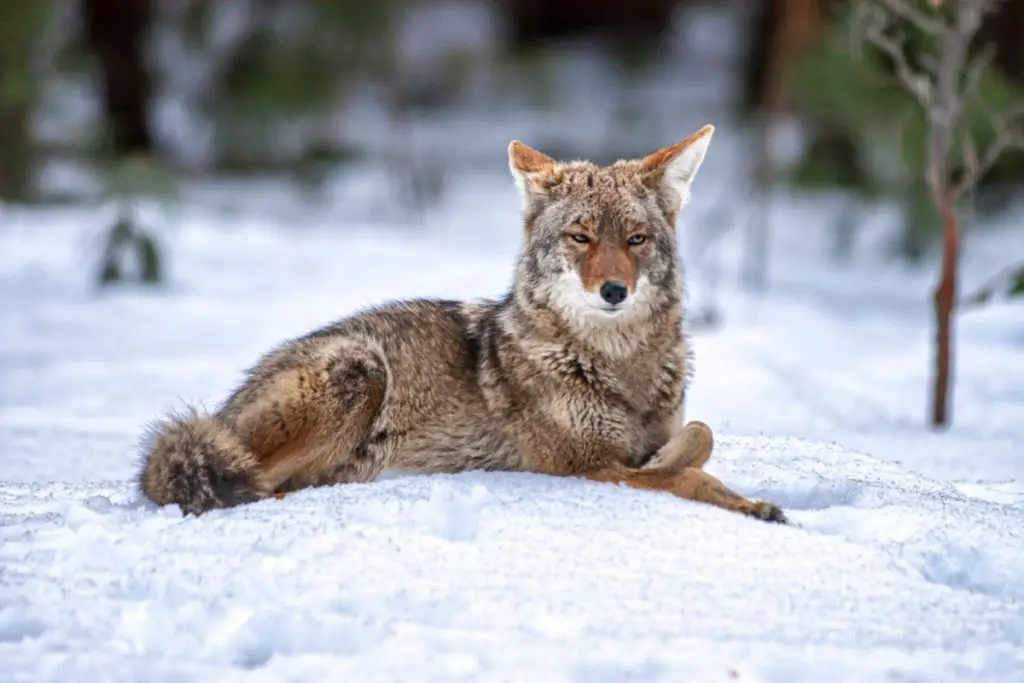Some animals in the wild have to hibernate through parts of the winter to survive. These animals usually have food sources that are not active or abundant during the winter months.
By eating large amounts of fat and food before the winter, they can slow down their metabolism and conserve their energy to survive. However, not all animals can do this.
Do Coyotes Migrate or Hibernate?
No coyotes do not hibernate or migrate. They stay in their home range for most of their lives and they do not need to hibernate, because they hunt and stay active all year long, including the winter months. The coyote’s fur is more than enough to keep them warm, in harsh cold conditions.
Coyotes do not need to hibernate through the winter because they stay actively hunting for food. Their prey is also active during the winter months, which helps coyotes to survive despite the cold temperatures.
What Do Coyotes Do in the Winter?
In the wintertime, coyotes remain just as active as they do at other times of the year. They seek shelter out in the open land, usually in a hollow tree or some other type of half-open structure. When it comes to survival, coyotes have been able to adapt and overcome many threats. Source.
Many of the small animals that coyotes prey on also remain active in the winter. This constant supply of food keeps them busy at a time of year when other animals have to hibernate and conserve energy.
In the winter, coyotes prey on animals such as rabbits, rodents, deer, small elk, and other animals that also thrive in the winter months.
How Do Coyotes Stay Warm in the Winter?
Coyotes are resilient and their fur helps them stay warm in the winter months. They move around a lot, always on the hunt for prey. This constant activity helps keep their bodies warm and their blood running.
There is no threat to coyotes in cold winters unless there is extreme cold and even then there are not many reports of coyotes having trouble. If they need shelter they find it, in the form of dens, caves, rock formations, hollowed-out wood, and more.
Check out our article How Smart Are Coyotes
Can Coyotes Survive Extreme Winter Conditions?
When it comes to extreme winter conditions, such as blizzards and other extreme weather, coyotes can get through it mostly without a problem. Only in the most extreme and unusual conditions would a coyote not survive the cold weather where it lives.
Originally, coyotes flourished in the great plains areas of North America. Since their expansion, they have dispersed to the Arctic and as far south as Mexico and Central America. The fact that they have been able to survive in all of these regions, means that coyotes are going to be around for a very long time.

What Other Animals are Active in the Winter?
Just like coyotes, many other animals are also active in the winter. Coyotes do not hibernate, but they will sometimes conserve some of their energy in the winter months if food sources are scarce. They are also opportunistic and will feed on carrion, left behind by other predators.
Animals that thrive in the winter:
- Muskrats
- Beavers
- Voles
- Mice
- Tree Squirrels
- Deer
- Rabbits
As you can probably tell, most of these animals are the animals that coyotes prey on. This is one reason that they can stay so active in the winter because the food sources are abundant in many winter regions. Coyotes are not able to slow down their metabolism the same way as other animals that hibernate do.
What Time of the Year are Coyotes Most Active?
Coyotes are active throughout the year. However, they do become more active during the mating season. This is because they are searching for a mate, expanding their territories, and communicating more with other coyotes in the area, in the form of howls, yips, and yelps.
The mating season happens between February and March, but sometimes the season starts a little early. In these early months of the year, coyote movements begin to expand, for new territory and relationships.
Do Coyotes Migrate in the Winter?
No, coyotes do not migrate or move to warmer areas during the winter. Their food supplies stay abundant and they can easily cope with harsh cold weather conditions. Their fur is thick and can withstand very cold temperatures.
Coyotes usually stay in their home range for most of their lives, including the winter seasons. Their home range consists of around 8 to 16 square miles.
Frequently Asked Questions
Yes, coyotes are active in the cold. In the winter months, coyotes can hunt and keep warm despite the cold temperatures. As long as the animals that coyotes prey on stay active, coyotes will be able to survive.
Winter can be a hard time for any time of animal in the wild. Even if nature has provided them with thick fur and skin. The winter months can still hit coyotes with extreme weather, winds, and sometimes shortages of food.
Yes, coyotes can freeze to death. Even animals that are built to withstand extremely cold conditions can freeze to death. There have been reports of coyotes freezing to death in ice storms.
- Hero Farm Dog Survives Epic Battle with Coyote Pack - December 9, 2024
- The 10-Minute Bedtime Routine That Changed My Dog’s Sleep Forever - November 29, 2024
- Creating a Safe Space for Nervous Pets: Your Guide to Pet-Friendly Havens - November 25, 2024

